|
|
|
Sort Order |
|
|
|
Items / Page
|
|
|
|
|
|
|
| Srl | Item |
| 1 |
ID:
118510
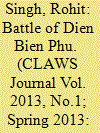

|
|
|
| 2 |
ID:
096399
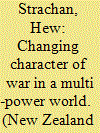

|
|
|
| 3 |
ID:
117975
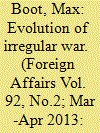

|
|
|
|
|
| Publication |
2013.
|
| Summary/Abstract |
Pundits tend to treat terrorism and guerrilla tactics as something new, but nothing could be further from the truth. Although the agendas have changed over the years -- from tribalism, to liberalism and nationalism, to socialism, to jihadist extremism -- guerrilla and terrorist warfare has been ubiquitous throughout history and consistently deadly.
|
|
|
|
|
|
|
|
|
|
|
|
|
|
|
|
| 4 |
ID:
160872
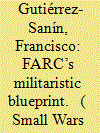

|
|
|
|
|
| Summary/Abstract |
This article intends to explain the outstanding sequence of success and failure exhibited by the FARC, the main Colombian guerrilla since the 1980s. It claims that such sequence is unintelligible unless the adoption by the FARC of a militaristic organizational blueprint at its 1982 7th Conference is taken into account. By building itself like an army, the FARC could boost its combat capacity, maintain its structural integrity, and develop powerful mechanisms that held the whole structure together. At the same time, the militarization of the FARC also entailed significant risks and costs like political isolation and high personnel turnover. After describing the militaristic blueprint, the article compares the FARC with other irregular forces that operated in the Colombian context – a comparison which is important to understand the specificity of the FARC trajectory, as well as the benefits and costs involved in it. The analysis highlights the critical role of organizational dimensions in the explanation of civil war outcomes, and suggests that at least for some problems organizational dynamics should be observed at a low level of granularity.
|
|
|
|
|
|
|
|
|
|
|
|
|
|
|
|
| 5 |
ID:
168207
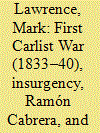

|
|
|
|
|
| Summary/Abstract |
The period 1833 to 1840 witnessed a brutal civil war in Spain waged between insurgent Carlists and the government Cristinos. The Carlists managed to secure reliable territorial control only over one part of Spain (upland Navarra and rural parts of the neighbouring Basque provinces). Although pockets of armed Carlism flourished elsewhere in Spain, especially in Catalonia, Aragón and Galicia, these insurgents were ineffective at coordinating actions. The Carlist court in the Basque country tried to break its strategic blockade by launching a series of expeditions into Cristino-held territory in the hope of destabilising the Madrid regime and consolidating distant insurrections. This article explains how and why these expeditions scored tactical victories but strategic failures. In particular it argues that Carlist raiding strategy was a failure, for its use of violence against real and imagined enemies in marginal and Cristino areas of control alienated civilian support.
|
|
|
|
|
|
|
|
|
|
|
|
|
|
|
|
| 6 |
ID:
081232
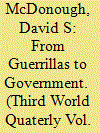

|
|
|
|
|
| Publication |
2008.
|
| Summary/Abstract |
Post-conflict stability remains an elusive goal for many African countries. The political and socioeconomic preconditions of African civil wars have often persisted after the end of open hostilities and have frustrated regional and international efforts at peace building. The growing role of non-state armed groups in post-conflict governments raises further questions on the important role of guerilla groups in either exacerbating or ameliorating the 'structural' preconditions of protracted African wars. The cases of Liberia, Uganda and Rwanda offer important insights on the complex interplay between armed groups and governments that underlie these conflicts. All three countries have been marked by devastating civil wars and the subsequent formation of post-conflict governments led by respective insurgent groups, but only Rwanda and Uganda have made any effort to mitigate the conditions that ultimately led to intra-state violence and state collapse. While the conflict dynamic may heavily condition an insurgent group, these factors alone do not play a determining role in the success or failure of peace building efforts
|
|
|
|
|
|
|
|
|
|
|
|
|
|
|
|
| 7 |
ID:
168210
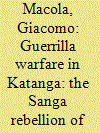

|
|
|
|
|
| Summary/Abstract |
This article discusses the origins and development of the Sanga insurgency of the 1890s with a view to demonstrating that, contrary to commonly held stereotypes, pre-colonial warfare was neither simple nor unchanging. Its tactics, it is argued here, repay the sort of close analysis commonly reserved for other typologies and theatres of war. The Yeke, against whose exploitative system of rule the Sanga and their allies rose up in 1891, survived the onslaught by entering into a strategic alliance with Lofoi, a newly established station of the Congo Free State, and its limited contingent of regular Force Publique troops. An in-depth examination of the joint Yeke-Force Publique counterinsurgency campaign leads to the conclusion that the novelty of the ‘small wars’ that accompanied the Scramble for Africa should not be overstated. In southern Katanga and, by implication, elsewhere, these confrontations were shaped by processes of mutual borrowing in which African military practices and even political aims were not necessarily subordinate to European ones.
|
|
|
|
|
|
|
|
|
|
|
|
|
|
|
|
| 8 |
ID:
123954
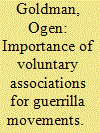

|
|
|
|
|
| Publication |
2013.
|
| Summary/Abstract |
The question I examine in this article is why is it that under certain circumstances a guerrilla movement succeeds while under others it fails? The hypotheses that I shall present below are the greater the number and variety of voluntary associations supporting the guerrilla movement, compared with the number of associations supporting the regime, the greater is the guerillas' level of success. Voluntary associations can fulfill the guerrilla's basic needs: resources, organizational ability, and obligation. Achieving these needs assist the guerrilla in realizing: population support; inter-class allies; military force; governmental function, which in turn allows the realization of the political objectives.
|
|
|
|
|
|
|
|
|
|
|
|
|
|
|
|
| 9 |
ID:
091489
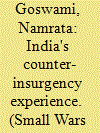

|
|
|
|
|
| Publication |
2009.
|
| Summary/Abstract |
The Indian Army, a force trained primarily for conventional warfare, has been engaged in internal counter-insurgency operations since the 1950s. Despite such a long innings on a counter-insurgency mode, little attention has been accorded within military circles to doctrinal innovation for waging sub-conventional warfare in India's democratic political context. At best, the Army continues to view counter-insurgency duty as secondary to its primary duty of defending India from external conventional threats. By conceptualizing a counter-insurgency strategy of 'trust and nurture', this article aims to fill this critical doctrinal gap in India's military policy. The author argues that a counter-insurgency strategy of 'trust and nurture' based on democratic political culture, measured military methods, special counter-insurgency forces, local social and cultural awareness and an integrative nation-building approach will result in positive handling of India's internal security problems. The author utilizes India's counter-insurgency experiences in Assam, Mizoram, Nagaland, Punjab, and Operation 'Sadhbhavana' in Jammu and Kashmir as illustrative empirical indicants in order to validate the 'trust and nurture' strategy.
|
|
|
|
|
|
|
|
|
|
|
|
|
|
|
|
| 10 |
ID:
141783
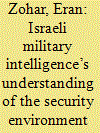

|
|
|
|
|
| Summary/Abstract |
The Arab Awakening was a strategic surprise for the Israeli military intelligence (AMAN), but did not cause immediate damage for the security of Israel because of the internal character of events. At an early stage AMAN recognized the general direction of the upheavals, which were more conflicts rather than the establishment of a democratic new order in the Middle East. The Arab Awakening operated as an intervening factor, escalating some of Israel’s major security challenges and de-escalating others. AMAN provided strategic intelligence warnings (of Iran’s military nuclear plan) and actionable intelligence (about Hezbollah’s infrastructure across the Syrian border), but presumed to assess the stability of regimes in a chaotic environment (Egypt, Syria), faced difficulties in monitoring capabilities of new actors (ISIS) and intentions of adversaries (Hamas). Fighting Hamas and Hezbollah, AMAN might subordinate itself to the strategy of deterrence rather than defeating the enemy. AMAN’s chiefs viewed the Arab Awakening as a facilitator to implement an unbalanced intelligence concept focusing on “shaping reality”, undermining the strategic analysis that must remain central to intelligence work.
|
|
|
|
|
|
|
|
|
|
|
|
|
|
|
|
| 11 |
ID:
143689
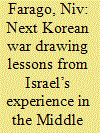

|
|
|
|
|
| Summary/Abstract |
What would an armed conflict between the two Koreas look like? The following analysis examines this question by drawing lessons from the history of military clashes between Israel and its Arab and Palestinian adversaries. Firstly, it suggests that an armed conflict on the Korean Peninsula would be limited in its scope. Although qualitatively inferior, the North Korean military could conduct a limited ground maneuver south to the DMZ by employing Egypt’s strategy in the 1973 Yom Kippur War. A South Korean counterattack would also be limited. Advancing too deep beyond the DMZ would provoke Pyongyang to go on a nuclear alert and encourage Chinese and American pressure on Seoul to pull back. A South Korean refusal to comply could invite foreign intervention, similar to the American intervention in the 1973 War. Secondly, this paper explores the challenge of guerrilla warfare (both above and below ground) that ROK forces are likely to encounter if they cross the DMZ. Israel’s experiences in the 2006 Lebanon War and in Operations Cast Lead (2008) and Protective Edge (2014) illustrate that in facing such a challenge, even an indisputably superior force may have to pay a heavy price in casualties. Given that North Korean nuclear deterrence would prevent ROK forces from implementing reunification war plans, South Korea should consider stopping its counterattack at the DMZ, rather than pursuing the enemy into a terra incognita of topographical and subterranean traps.
|
|
|
|
|
|
|
|
|
|
|
|
|
|
|
|
| 12 |
ID:
058890
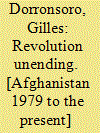

|
|
|
|
|
| Publication |
London, Hurst & Company, 2005.
|
| Description |
xxiii, 370p.pbk
|
| Series |
CERI Series in Comparative Politics and International Studies
|
| Contents |
Translated from the French
|
| Standard Number |
1850657033
|
|
|
|
|
|
|
|
|
|
|
|
Copies: C:1/I:0,R:0,Q:0
Circulation
| Accession# | Call# | Current Location | Status | Policy | Location |
| 049163 | 958.1045/DOR 049163 | Main | On Shelf | General | |
|
|
|
|
| 13 |
ID:
093806
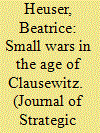

|
|
|
|
|
| Publication |
2010.
|
| Summary/Abstract |
Around the time of Clausewitz's writing, a new element was introduced into partisan warfare: ideology. Previously, under the ancien rgime, partisans were what today we would call special forces, light infantry or cavalry, almost always mercenaries, carrying out special operations, while the main action in war took place between regular armies. Clausewitz lectured his students on such 'small wars'. In the American War of Independence and the resistance against Napoleon and his allies, operations carried out by such partisans merged with counter-revolutionary, nationalist insurgencies, but these Clausewitz analysed in a distinct category, 'people's war'. Small wars, people's war, etc. should thus not be thought of as monopoly of either the political Right or the Left.
|
|
|
|
|
|
|
|
|
|
|
|
|
|
|
|
| 14 |
ID:
063553
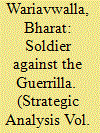

|
|
|
|
|
| Publication |
May-Jun 1985.
|
|
|
|
|
|
|
|
|
|
|
|
|
|
|
|
| 15 |
ID:
079231
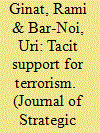

|
|
|
|
|
| Publication |
2007.
|
| Summary/Abstract |
This article demonstrates the inconsistent and wavering Soviet attitude towards national liberation movements in general and the Palestinian organizations in particular. Until the late 1960s, the Soviets viewed these organizations with suspicion, hesitating to engage in political dialogue with them. However, in the 1970s, political and military events in the region, as well as modifications in the Kremlin's Cold War strategies, led to a general shift towards the Middle East in Soviet foreign policy. Soviet leaders showed increased willingness to provide certain Palestinian organizations with arms with which to conduct terrorist activities against Israeli, pro-Israeli, Jewish and Western targets. The article explores the complex relations between Palestinian organizations and the USSR in the field of international terror. The study also exposes and analyzes the nature and content of Soviet-Palestinian arms dialogues and transactions. It provides clear evidence that Soviet policymakers and other luminaries were fully informed of, and sometimes directly involved in, these transactions and dialogues at the highest levels
|
|
|
|
|
|
|
|
|
|
|
|
|
|
|
|
| 16 |
ID:
087353
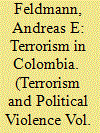

|
|
|
|
|
| Publication |
2009.
|
| Summary/Abstract |
This article examines contemporary uses of terrorism in Colombia. Combining an historical analysis with the most complete database available on political violence, we illustrate how terrorism in Colombia constitutes a specific strategy that can be distinguished from other manifestations of violence. We argue that Colombia's non-state armed groups have turned terrorism into a pivotal element of their repertoires of action. These parties have not only increased their reliance on this strategy and introduced more refined forms such as de-territorialized terrorism, but also have specialized in particular terrorist attacks that suit their general objectives. While paramilitary groups rely mostly on massacres and forced disappearance, guerrillas concentrate on agitational terrorism including kidnappings and indiscriminate bombings.
|
|
|
|
|
|
|
|
|
|
|
|
|
|
|
|
| 17 |
ID:
081261
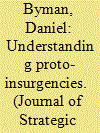

|
|
|
|
|
| Publication |
2008.
|
| Summary/Abstract |
Why do some small terrorist and guerrilla groups succeed in becoming full-blown insurgencies while many others fail? Proto-insurgencies face many difficulties in creating an insurgent movement: they must create a politically salient identity, harness a compelling cause, create an effective sanctuary, and defeat both violent and peaceful organizational rivals, all while evading the police and security services of the much more powerful state. Outside support is a mixed blessing for proto-insurgents. Often, the ultimate success of the proto-insurgency in becoming a full-blown insurgency depends on the mistakes of the government it opposes.
|
|
|
|
|
|
|
|
|
|
|
|
|
|
|
|
| 18 |
ID:
125942
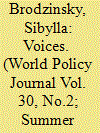

|
|
|
|
|
| Publication |
2013.
|
| Summary/Abstract |
BOGOTÁ-For much of the first half of 2012, Colombia hardly seemed on the path to peace. As they have done for the past half-century, leftist rebels ambushed soldiers, destroyed oil pipelines, set off bombs, and plotted against the government. Government forces, for their part, launched attacks on rebel camps, captured and killed guerrilla leaders, and welcomed deserters.
|
|
|
|
|
|
|
|
|
|
|
|
|
|
|
|
| 19 |
ID:
107994


|
|
|
|
|
| Publication |
2011.
|
| Summary/Abstract |
There is no consensus in the literature about the nature of terrorism. The authors' main claim is that this is ultimately the result of the coexistence of two senses of the term, the action and the actor sense, which are not fully congruent. Rather than trying to advocate a specific conceptualization, the authors provide in this article a map of the different ways in which scholars talk about terrorism. They identify first the set of terrorist actions and the set of terrorist actors. Terrorist tactics are a variety of the power to hurt, based on the lack of military power. Terrorist groups are underground ones with no territorial control. When the two criteria meet, the core of terrorism exists: coercive violence perpetrated by underground groups. The ambiguity that surrounds terrorism is caused by two other possibilities: actors with some measure of territorial control adopting coercive tactics and underground actors adopting military tactics. Although it is not possible to remove this ambiguity in empirical research, scholars can at least identify it and analyze it. The authors illustrate the two senses of terrorism and their interaction by using the most comprehensive dataset on terrorist incidents, the Global Terrorism Database (GTD).
|
|
|
|
|
|
|
|
|
|
|
|
|
|
|
|
| 20 |
ID:
098452
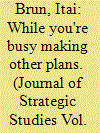

|
|
|
|
|
| Publication |
2010.
|
| Summary/Abstract |
This study argues that, in parallel to the developments in the West over the last three decades, several nations and organizations on 'the other side of the hill' have also undertaken a significant development in their military thought. This conceptual development is referred to in the study as the 'Other RMA' ('O-RMA'). This study aims to identify and describe O-RMA, to analyze the learning process that led to it and to trace its intellectual origins. This 'way of war', whose roots lie in a series of dramatic and tumultuous events that took place in the Middle East between the years 1979 and 1982, is based on the following components: Improving absorption capability, in order to increase survivability and provide a breathing space for the 'weaker side', creating effective deterrence, in order to deter the 'stronger side' from attacking the 'weaker side' and shifting the war to more convenient areas in case this deterrent fails; and winning the war by not losing it, while creating an attrition effect. O-RMA is an exceptionally eclectic conception and its development was not intentional or systematic. This study claims that the main ideas that underlie this conceptual development evolved within the different elements, while maintaining a common image, concerning the military, technological, economic, social and political developments in the West during the 1990s.
|
|
|
|
|
|
|
|
|
|
|
|
|
|
|
|
|
|
|
|
|